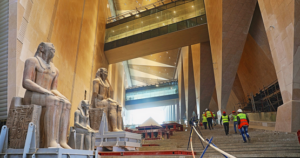When the Grand Egyptian Museum (GEM) opens its doors to the world in 2022, it will be the largest archaeological museum complex in the world. The museum will host more than 100,000 artifacts, 20,000 of which have never previously been on display.
For the first time ever, King Tutankhamun’s entire treasure collection will be on display, as well as the shrines of the boy King. Artifacts from pre-historic times also will be featured, through Egypt’s many thousands of years of Pharaonic civilization, to the ancient Greek and Roman periods of Egyptian history.
An early part of the process of construction involved transporting a 3,200-year-old statue of ancient Egyptian King Ramses, weighing 83 tonnes, into its new home in the museum’s atrium. This £550,000 operation involved Army engineers and specialist contractors moving the giant colossus inside a cage suspended from a steel beam mounted on a truck, on road surfaces specially treated to ensure they could bear the weight.
Once the statue was in place, the atrium was built around it.
Hill International is an American construction consulting firm that provides services including programme and project management to clients involved in major schemes around the globe.
Islamic halal slaughter banned in Greece, Supreme Court rules
Waleed Abdel Fattah, senior VP at Hill International, and project manager for GEM spoke about the ambitious project, which will cost over a billion dollars. “The Grand Egyptian Museum is one of the greatest cultural projects happening in the world now,” he says, detailing the construction:
“The designers have created the building on a north-south axis, matching the old temples. The total area of the project is almost 491,000 square meters. The exhibition area, comprising around 100,000 artifacts, is 62,000 meters.”
GEM is, he points out, not confined to the museum galleries:
“It also includes the conference center, a children’s museum, education facilities, the food court, and extensive gardens. One of the marks of the project is the outside pyramid wall”.
Read more: Blooloop
Ask me anything
Explore related questions





